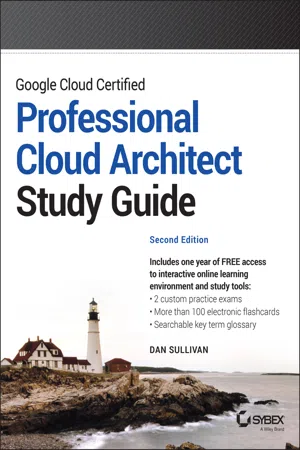
- English
- ePUB (mobile friendly)
- Available on iOS & Android
Google Cloud Certified Professional Cloud Architect Study Guide
About this book
An indispensable guide to the newest version of the Google Certified Professional Cloud Architect certification
The newly revised Second Edition of the Google Cloud Certified Professional Cloud Architect Study Guide delivers a proven and effective roadmap to success on the latest Professional Cloud Architect accreditation exam from Google. You'll learn the skills you need to excel on the test and in the field, with coverage of every exam objective and competency, including focus areas of the latest exam such as Kubernetes, Anthos, and multi-cloud architectures. The book explores the design, analysis, development, operations, and migration components of the job, with intuitively organized lessons that align with the real-world job responsibilities of a Google Cloud professional and with the PCA exam topics. Architects need more than the ability to recall facts about cloud services, they need to be able to reason about design decisions. This study guide is unique in how it helps you learn to think like an architect: understand requirements, assess constraints, choose appropriate architecture patterns, and consider the operational characteristics of the systems you design.Review questions and practice exams use scenario-based questions like those on the certification exam to build the test taking skills you will need.
In addition to comprehensive material on compute resources, storage systems, networks, security, legal and regulatory compliance, reliability design, technical and business processes, and more, you'll get:
- The chance to begin or advance your career as an in-demand Google Cloud IT professional
- Invaluable opportunities to develop and practice the skills you'll need as a Google Cloud Architect
- Access to the Sybex online learning center, with chapter review questions, full-length practice exams, hundreds of electronic flashcards, and a glossary of key terms
The ideal resource for anyone preparing for the Professional Cloud Architect certification from Google, Google Cloud Certified Professional Cloud Architect Study Guide, 2nd Edition is also a must-read resource for aspiring and practicing cloud professionals seeking to expand or improve their technical skillset and improve their effectiveness in the field.
Frequently asked questions
- Essential is ideal for learners and professionals who enjoy exploring a wide range of subjects. Access the Essential Library with 800,000+ trusted titles and best-sellers across business, personal growth, and the humanities. Includes unlimited reading time and Standard Read Aloud voice.
- Complete: Perfect for advanced learners and researchers needing full, unrestricted access. Unlock 1.4M+ books across hundreds of subjects, including academic and specialized titles. The Complete Plan also includes advanced features like Premium Read Aloud and Research Assistant.
Please note we cannot support devices running on iOS 13 and Android 7 or earlier. Learn more about using the app.
Information
Chapter 1
Introduction to the Google Professional Cloud Architect Exam
- Section 1: Designing and planning a cloud solution architecture
- 1.1 Designing a solution infrastructure that meets business requirements. Considerations include:
- Business use cases and product strategy
- Cost optimization
- Supporting the application design
- Integration with external systems
- Movement of data
- Design decision tradeoffs
- Build, buy, modify, or deprecate
- Success measurements (e.g., Key Performance Indicators (KPI), Return on Investment (ROI), metrics)
- Compliance and observability
- 1.1 Designing a solution infrastructure that meets business requirements. Considerations include:
- Exam objectives
- Scope of the exam
- Case studies written by Google and used as the basis for some exam questions
- Additional resources to help in your exam preparation
Exam Objectives
- Planning cloud solutions
- Managing and provisioning cloud solutions
- Securing systems and processes
- Analyzing and optimizing technical and business processes
- Managing implementations
- Ensuring solution and operations reliability
Analyzing Business Requirements
- The need to reduce capital expenditures
- Accelerating the pace of software development
- Reporting on service-level objectives
- Reducing time to recover from an incident
- Improving compliance with industry regulations
Reducing Operational Expenses
Accelerating the Pace of Development
Table of contents
- Cover
- Table of Contents
- Title Page
- Copyright
- Dedication
- Acknowledgments
- About the Author
- About the Technical Editors
- Introduction
- Chapter 1: Introduction to the Google Professional Cloud Architect Exam
- Chapter 2: Designing Solutions to Meet Business Requirements
- Chapter 3: Designing Solutions to Meet Technical Requirements
- Chapter 4: Designing Compute Systems
- Chapter 5: Designing Storage Systems
- Chapter 6: Designing Networks
- Chapter 7: Designing for Security and Legal Compliance
- Chapter 8: Designing for Reliability
- Chapter 9: Analyzing and Defining Technical Processes
- Chapter 10: Analyzing and Defining Business Processes
- Chapter 11: Development and Operations
- Chapter 12: Migration Planning
- Appendix: Answers to the Review Questions
- Index
- End User License Agreement